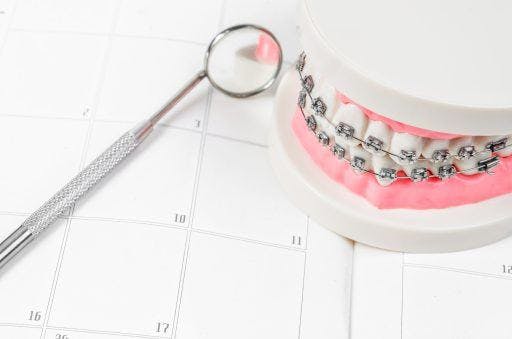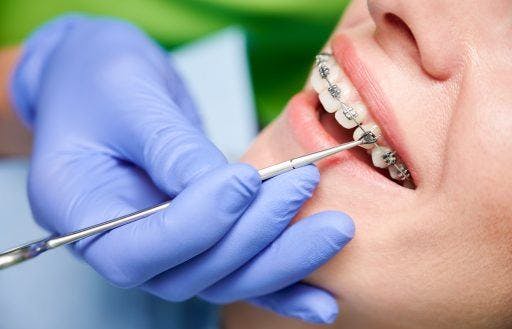Do you suffer from constant headaches and neck pain that paracetamol doesn’t seem to cure? Your teeth or jaw could be to blame, and you may not even realise it. Schedule a dental visit to confirm whether your problems are orthodontic in nature. If they are, treatment can range from simple metal braces to surgery, depending on the complexity.
For the most part, orthodontists often recommend the non-surgical approach – braces! If wearing these alignment correctors is in your future, here are a few things you need to know.
What are metal braces?

Braces are designed to align teeth or correct your bite for structural, cosmetic, or health purposes. These orthodontic devices apply gentle pressure on teeth to move them into their correct positions.
Traditional or metal braces are the most common type of orthodontic appliance. Earlier versions of these metal aligners were very bulky and noticeable. Fortunately, current designs are smaller, more comfortable, and highly effective.
Metal braces involve bonding brackets directly onto teeth before threading a flexible wire through them. The wire holds the braces together while customisable, coloured bands keep them in place. Braces require regular adjustment, with patients scheduling visits every four to eight weeks.
Are metal braces worth it?
You may encounter challenges and discomfort before and during orthodontic treatment, but the benefits definitely outweigh these temporary issues. Correcting alignment problems early can result in perfect pearly whites. Ignoring these issues can lead to health problems like:
- Tooth decay
- Gum disease
- Abnormal tooth enamel wear
- Affected speech
- Tooth loss
- Affected chewing
- Headaches
- Neck pain
Pros of metal braces

Selecting which treatment plan is best for you can be tricky. It helps to know the pros and cons of braces for adults.
1. Metal braces are widely available.
The technology behind metal braces is straightforward, making them widely accessible. Plus, they may be more affordable than other options. Before signing up for orthodontic treatment, check if your private health insurance policy includes braces. This is often found with extras cover, where you receive a lump sum that will cover a portion of the cost. So it is well worth checking!
2. Metal braces can address complex dental issues.
When properly applied to your teeth, braces can help treat numerous health-related and functional concerns. Metal braces can be more effective than other methods at addressing teeth overcrowding, overbites, and underbites – typically related conditions that can lead to more problems if left untreated.
Take this online smile assessment to find out if you’re dealing with these issues.
3. They can be less expensive than other options for minor teeth corrections.
Braces are beneficial for those with a tight budget. They are a fraction of the cost of aligners. Many clinics even offer instalment plans to make payment easier for their clients.
4. Metal braces are very durable.
Their durability makes them a great choice for complex alignment issues. Because braces can withstand daily tension and stress, repairs and replacements are rare. In the end, you will need to discuss with your dentist if they are the right option for you.
Cons of metal braces
Before you make a decision, learn about the disadvantages of metal braces first.
1. Metal braces are the most visible of all types of braces.
Aesthetics can be a crucial consideration when you work in industries prioritising appearance (i.e., beauty, service delivery, hospitality). If you’re looking for a subtle teeth appliance, there are better-looking solutions than metal aligners.
2. Metal braces require regular adjustments for the treatment to progress.
Metal orthodontic aligners require dedication and commitment. Regular checkups and adjustments are necessary to see results. Discuss the schedule with your orthodontist so you can plot it in your calendar accordingly.
3. Braces may cause discomfort.
Getting used to metal braces may take a few days or weeks. Discomfort can go away depending on how well you adjust to the braces. Some patients experience mouth sores and wounds due to the sharp edges of the metal components.
Other types of dental braces
Besides metal braces, there are multiple ways you can have straighter teeth. You might be wondering, “is it better to get clear or metal braces?” Your orthodontic treatment depends on personal preference and what your dentist recommends.
To help you decide the best treatment plan, learn about the different types of braces.
Ceramic braces
Ceramic braces are more discreet, with components made of tooth-coloured material. This variety works similarly to metal braces but is much more visually subtle. The downside? They are slightly larger than metal ones. These braces can also stain depending on hygiene and dietary habits.
Self-ligating braces
Self-ligating braces feature special brackets with a mechanism that holds the wires in place, allowing you to forgo ligatures. For some, the lack of elastic bands makes these braces less apparent than traditional braces. According to the Australian Society of Orthodontics (ASO), another advantage of these braces is that food particles are less likely to get caught in them.
Lingual braces
Lingual braces are as inconspicuous as fixed appliances can get. Some call them “inside” braces because your dentist attaches them to the inside of your teeth. Other people won’t see them unless you open your mouth or point them out. As such, they can be even more subtle than clear aligners.
But you still need to take care of them similarly to traditional braces. That means watching what you eat and maintaining excellent oral hygiene, no matter how inconvenient or difficult. The ASO points out that wearers of lingual braces may experience initial speech difficulty, tongue irritation, and ulceration as these braces sit close to the tongue.
Metal braces vs clear aligners
In the last decade, clear aligners have seen a surge in popularity. Compared to traditional braces, aligners like ClearCorrect use custom-fit “invisible” plastic trays for a more natural look. These transparent moulds gradually move teeth into the desired position. Because aligners are removable, wearers don’t need to restrict their diet. This feature also makes brushing and flossing hassle-free.
Transparent aligners are terrific for patients who’ve had braces in the past and require a “touch-up” – which happens to many adults. Orthodontists typically recommend them for individuals with mild to moderate teeth misalignments.
Comfort
With all those brackets and wires, metal braces can cause irritation, sores, and blisters on your gums, the lining of the cheeks, and lips. Meanwhile, aligners offer more comfort because of the smooth material. You’ll only experience a little discomfort when you get adjustments, which are less frequent than with braces.
Commitment
Once you get braces, you have them on 24/7. On the other hand, for aligners to be effective, you need to wear them for 18 to 22 hours per day. You have a couple of hours of breathing time for eating and cleaning your teeth. Aligners require a higher level of commitment than braces.
Maintenance
Expect to go through multiple dental appointments when you opt for braces. You’ll need to have the brackets affixed, then have the wires tightened often. Sometimes, you’ll also need to come in to replace missing parts. Clear aligners are much more straightforward.
For example, ClearCorrect uses ClearPilot, a powerful digital planning tool that lets your dentist map out every detail of your treatment. This personalised approach also allows you to visualise every step and anticipate outcomes.
Cleanliness
Metal braces make it difficult to reach the nooks and crannies of your teeth and achieve a thorough clean. This problem might even lead you to bad breath, discolouration, and tooth decay. You won’t have to worry about this with ClearCorrect aligners because you can slip them off any time, allowing you to clean your teeth as usual.
Cost
According to the ASO, metal braces cost AUD$6,000 to AUD$9,000, while clear aligners range from AUD$6,500 to AUD$9,500. However, various factors, like treatment duration and professional fees, can cause the price to change. Consider also how braces will require more visits to the dentist, incurring more expenses.
For many years, metal braces stood unchallenged as a treatment for alignment issues. However, clear aligners have been stepping up to the challenge of straightening people’s teeth. ClearCorrect is equally capable of addressing countless oral problems, and its technology guarantees durability, comfort, and competitive pricing. Contact your dentist to learn more about the advances transparent braces offer.



